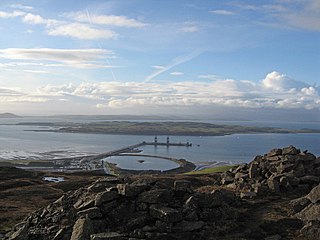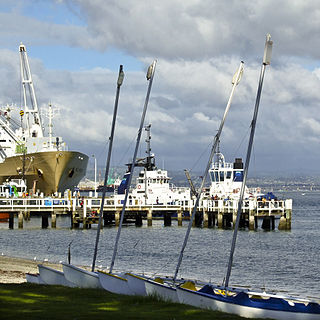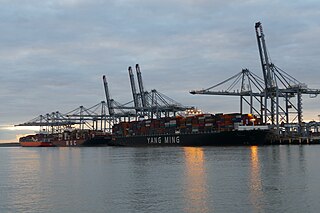
A container crane is a type of large dockside gantry crane found at container terminals for loading and unloading intermodal containers from container ships.

The Port of Tanjung Pelepas is a container port located in Gelang Patah, Iskandar Puteri, Johor Bahru District, Johor, Malaysia, and is part of the APM Terminals Global Terminal Network, which holds a minority share in the joint venture. On 13 March 2000, the harbor held its inauguration ceremony, which was officiated by Prime Minister Mahathir Mohamad.

Chennai Port, formerly known as Madras Port, is the second largest container port of India, behind Mumbai's Nhava Sheva. The port is the largest one in the Bay of Bengal. It is the third-oldest port among the 13 major ports of India with official port operations beginning in 1881, although maritime trade started much earlier in 1639 on the undeveloped shore. It is an artificial and all-weather port with wet docks. Once a major travel port, it became a major container port in the post-Independence era. An established port of trade of British India since the 1600s, the port remains a primary reason for the economic growth of Tamil Nadu, especially for the manufacturing boom in South India, and has contributed greatly to the development of the city of Chennai. It is due to the existence of the port that the city of Chennai eventually became known as the Gateway of South India.

Belfast Harbour is a major maritime hub in Belfast, Northern Ireland, handling 67% of Northern Ireland's seaborne trade and about 25% of the maritime trade of the entire island of Ireland. It is a vital gateway for raw materials, exports and consumer goods, and is also Northern Ireland's leading logistics and distribution hub.

A gantry crane is a crane built atop a gantry, which is a structure used to straddle an object or workspace. They can range from enormous "full" gantry cranes, capable of lifting some of the heaviest loads in the world, to small shop cranes, used for tasks such as lifting automobile engines out of vehicles. They are also called portal cranes, the "portal" being the empty space straddled by the gantry.

The Port of Karachi is one of South Asia's largest and busiest deep-water seaports, handling about 60% of the nation's cargo located in Karachi, Pakistan. It is located on the Karachi Harbour, between Kiamari Azra Langri, Manora, and Kakapir, and close to Karachi's main business district and several industrial areas. The geographic position of the port places it in close proximity to major shipping routes such as the Strait of Hormuz. The administration of the port is carried out by the Karachi Port Trust, which was established in 1857.

Hunterston Terminal, in North Ayrshire, Scotland, was an iron ore and coal-handling port located at Fairlie on the Firth of Clyde, operated by Clydeport which was taken over by The Peel Group in 2003. It lies south of Fairlie, adjacent to Hunterston estate, site of Hunterston Castle, and its jetty projects out approximately 1 mile (1.6 km), about midway into the channel between the mainland and the island of Great Cumbrae.

The Port of Haydarpaşa, also known as the Port of Haidar Pasha or the Port of Istanbul, is a general cargo seaport, ro-ro and container terminal, situated in Haydarpaşa, Istanbul, Turkey at the southern entrance to the Bosphorus, near Haydarpaşa Station. It is operated by the Turkish State Railways (TCDD) and serves a hinterland which includes the country's most industrialised areas.

The Port of Le Havre is the Port and port authority of the French city of Le Havre. It is the second-largest commercial port in France in terms of overall tonnage, and the largest container port, with three sets of terminals. It can accommodate all sizes of world cruise liners, and a major new marina is being planned. Le Havre is linked to Portsmouth, England, by Brittany Ferries.

The Port of Tauranga is situated in Tauranga, New Zealand. It is the largest port in the country both in terms of total cargo volume, and in terms of container throughput with container volumes exceeding 1.2 million TEUs. The port is operated by Port of Tauranga Ltd. This article is about both the company and the port itself.

Wells Harbour is located in the town of Wells-next-the-Sea in the county of Norfolk, England. The harbour is 21 miles west of Cromer, 34.8 miles north of Norwich and 123 miles north of London. The harbour lies north of the A149 between King’s Lynn and Great Yarmouth. The nearest railway station is now at Sheringham for the Bittern Line which runs between Sheringham, Cromer and Norwich. The nearest airport is Norwich International Airport.

DP World London Gateway is a port within the wider Port of London, United Kingdom. Opened in November 2013, the site is a fully integrated logistics facility, consisting of a semi-automated deep-sea container terminal which is on the same site as a land bank for the development of warehousing, distribution facilities, and ancillary logistics services.

The Port of Lowestoft is a harbour and commercial port in Lowestoft in the English county of Suffolk owned by Associated British Ports. It is the most easterly harbour in the United Kingdom and has direct sea access to the North Sea. The harbour is made up of two sections divided by a bascule bridge. The inner harbour is formed by Lake Lothing whilst the outer harbour is constructed from breakwaters. Lowestoft handles around 30,000 tonnes of cargo per year.

The Port of Colombo Sinhala: කොළඹ වරාය, Tamil: கொழும்பு துறைமுகம் is the largest and busiest port in Sri Lanka and the Indian Ocean. Located in Colombo, on the southwestern shores on the Kelani River, it serves as an important terminal in Asia due to its strategic location in the Indian Ocean. During the 1980s, the port underwent rapid modernization with the installation of cranes, gantries and other modern-day terminal requirements.

The Port international de Port-au-Prince is the seaport in the capital of Haiti, Port-au-Prince. It suffered catastrophic damage in the 2010 Haiti earthquake.

The Port of Cork is the main port serving the South of Ireland, County Cork and Cork City. It is one of the three "Ports of National Significance " as designated by National Ports Policy.

Lekki Deep Sea Port, is a multi-purpose, deep sea port in the Lagos Free Zone and is the only currently operating deep sea port in the country, having started full commercial operations in April 2023.

Mundra Port is India's first private port, largest container port and largest commercial port, located on the northern shores of the Gulf of Kutch near Mundra, Kutch district, Gujarat. Formerly operated by Mundra Port and Special Economic Zone Limited (MPSEZ) owned by Adani Group, it was later expanded into Adani Ports & SEZ Limited (APSEZ) managing several ports. In FY 2020–21, Mundra Port handled 144.4 million tonnes of cargo. The port currently handles over 155 MT, which constitutes nearly 11 per cent of India’s maritime cargo. The port also handles nearly 33 per cent of India’s container traffic.

Liverpool2 is a container terminal extension adjoining the River Mersey in Seaforth, Merseyside. The extension, built by Peel Ports, officially opened on 4 November 2016 and is an expansion of the Seaforth Dock container terminal.
Apapa Port Complex also known as the Lagos Port Complex is Nigeria's largest and busiest port complex. The complex consist of a number of facilities including Apapa quays, Third Apapa Wharf Extension, Apapa Dockyard, Apapa Petroleum Wharf, Bulk Vegetable Oil Wharf, Ijora Wharf, Kirikiri Lighter Terminal, and Lily pond inland container terminal. Financed and built by the colonial government of Nigeria, It became the nation's busiest port for exporting agricultural produce from the provinces of Western and Northern Nigeria in the late 1920s. Administration was transferred to the Nigerian government upon the granting of self-government and In 2005, the complex was divided into terminals and contracted out to private operators with NPA acting as the landlord and regulator.























